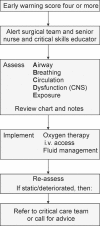The value of Modified Early Warning Score (MEWS) in surgical in-patients: a prospective observational study
- PMID: 17059720
- PMCID: PMC1963767
- DOI: 10.1308/003588406X130615
The value of Modified Early Warning Score (MEWS) in surgical in-patients: a prospective observational study
Abstract
Introduction: The Modified Early Warning Score (MEWS) is a simple, physiological score that may allow improvement in the quality and safety of management provided to surgical ward patients. The primary purpose is to prevent delay in intervention or transfer of critically ill patients.
Patients and methods: A total of 334 consecutive ward patients were prospectively studied. MEWS were recorded on all patients and the primary end-point was transfer to ITU or HDU.
Results: Fifty-seven (17%) ward patients triggered the call-out algorithm by scoring four or more on MEWS. Emergency patients were more likely to trigger the system than elective patients. Sixteen (5% of the total) patients were admitted to the ITU or HDU. MEWS with a threshold of four or more was 75% sensitive and 83% specific for patients who required transfer to ITU or HDU.
Conclusions: The MEWS in association with a call-out algorithm is a useful and appropriate risk-management tool that should be implemented for all surgical in-patients.
Figures
References
-
- Audit Commission. Critical to Success: The Place of Efficient and Effective Critical Care Services Within the Acute Hospital. London: Audit Commission; 1999.
-
- Stenhouse C, Coates S, Tivey M, Allsop P, Parker T. Prospective evaluation of a modified Early Warning Score to aid earlier detection of patients developing critical illness on a general surgical ward [Abstract] Br J Anaesth. 1999;84:663P.
-
- Morgan RJM, Williams F, Wright MM. An early warning scoring system for detecting developing critical illness. Clin Intensive Care. 1997;8:100.
-
- Carberry M. Implementing the modified early warning system: our experiences. Nurs Crit Care. 2002;7:220–6. - PubMed
-
- Subbe CP, Kruger M, Rutherford P, Gemmel L. Validation of a modified Early Warning Score in medical admissions. Q J Med. 2001;94:507–10. - PubMed
Publication types
MeSH terms
LinkOut - more resources
Full Text Sources
Other Literature Sources
Medical
Miscellaneous


